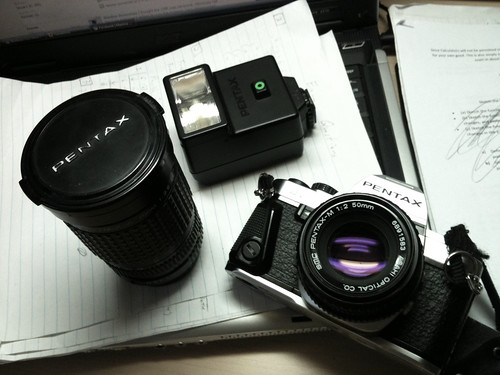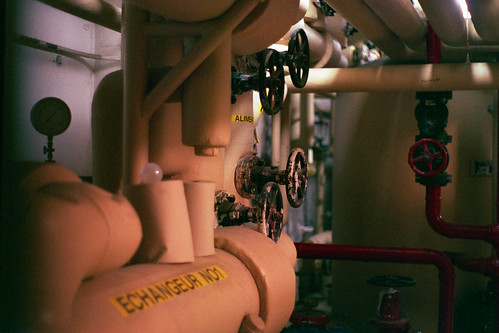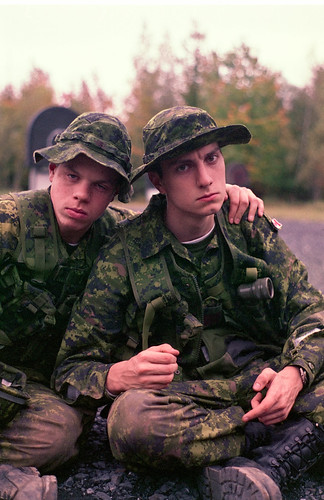My Return to 35mm: Pentax Rig & Opticfilm 7200
Digital photography isn’t a fact anymore, it’s a standard. When I bought my DSLR over a year ago, I never even considered film as a viable option, even though my father’s Pentax Super Program was just begging to be used, old and dusty in a long forgotten bag. It’s not practical, it’s clunky, it’s expensive… every reason was good not to pack to the Pentax. I skipped a considerable number of good shots because of that.
Fast forward to now, and my D40 is lots somewhere in New Jersey, hopefully on it’s way to Corin’s place (hey thanks USPS!), and I have no replacement DSLR. In fact, the only piece of my DSLR kit remaining is my beloved 35mm F1.8 DX. But a guy can’t stop taking pictures just like that… so out comes the Pentax and becomes my main photo rig ad interim.
The kit is pretty simple. My father had already purchased the essentials of an SLR rig back in his college days somewhere in the 80’s: Super Program body, which probably came bundled with the SMC A 35-105mm f3.5, and a Pentax AF200T flashgun. The body is just as slim as any manual 35mm camera was back in the days, and it’s very, very simple. No AF, a 5 character display, most of the action goes on at the lens. I later bought a used fixed focal pancake, an SMC M 50mm f2 for a couple of coins and a handshake. The first time I ever used it was back in my trip to Europe, where I brought it along as a lighter, more compact and rugged substitute to my D40, with the hopes of capturing the old continent on an old-timey medium. 20+ years old but it still works like a charm.
But of course with film, there’s more to taking a picture than just pressing the shutter release: after that comes developing and processing. That’s the part that’s been giving me grief. There’s no such thing as instant gratification with film, it’s all a waiting game. If you don’t shoot an entire roll, you either waste precious frames and wind it back regardless, or wait for an occasion to shoot the remainder. Then, the lab: trust me, this isn’t 1995 anymore, there is no such thing as a 1 hour photo service in today’s world. I was willing to cope with the situation, because after all, I’m the sucker who sold my DSLR. But when I got charged 9$ for a CD of shitty 3MP scans + developed negatives. I knew that I couldn’t do with that. So I took the matter in my own hands: I bought a Plustek Opticfilm 7200.

I really didn’t know what to expect, as most of the other types of analog to digital conversion processes I had witnessed before were always kind of sketchy and usually yielded less than perfect results, tape to mpg are a good example. I had shopped around for film scanners, and it seemed that most of the products available were either way shitty or way expensive. It took a while before I found out the perfect compromise. At 250$CAD, the Opticfilm 7200 is a very capable scanner which digitizes 35mm and mounted slide to up to 7200 DPI in either JPG or tiff, and produces surprisingly good results. I’ll be honest, you have to have some time on your hands if you want to scan your negatives, because it’s a multi-step process. But if you put in the effort for preparing the negatives and doing all the dusting work and editing in Photoshop, you will get EXCELLENT results.
So far, I’ve done only a couple of scans since I was lacking the proper stuff for cleaning up my film, but the few that I’ve done turned out great. A gentle swipe with a microfiber cloth soaked in rubbing alcohol, a little shot of compressed air to get rid of whatever leftovers, and you’re good to scan. In a dusty environment like my dorm (for some reason the vents here spit out dust like crazy), there is always a bit of correction work to be done in Photoshop, but it’s nothing the heal tool can’t take care of. Here is what I have so far:
All the shots were taken with the 50mm f2 on some Fuji Superia 400, the film I shoot most regularly. Resolution is great, as you can see from the full size jpegs available from Flickr. I could no doubt get some pretty nice big prints with that, and I’m not even topping off the resolution settings on the scanner. I don’t know if the sludgy noise is caused by my film or by the scanner, but in the even that it is the film, I’d be able to print off some good looking poster sized prints for sure.
All in all, this Plustek scanner is a great tool, but it’s only as good as the effort you put into making your snaps look good.
I also wanted to give a short little shoutout to the people running Onhop.ca, the place where I bought the scanner. In addition to having the lowest CAD price anywhere for this item, they were very courteous on the phone when I called to discuss a problem concerning the length of my address, and the shipping was just insanely fast: 36 hours from their warehouse to my doorstep! They don’t have much of a reputation compared to giants like Newegg and Tiger, but I strongly recommend checking them out if you’re looking for electronics and random computer doodads.



